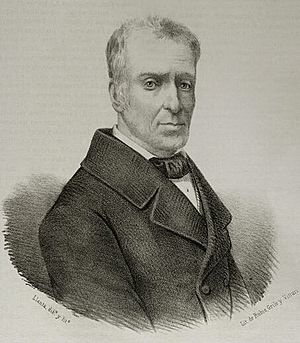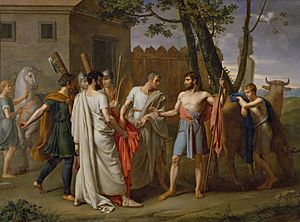Juan Antonio Ribera facts for kids
Juan Antonio Ribera Fernandez (born May 27, 1779 – died June 15, 1860) was an important Spanish painter. He is also known as Juan Antonio de Ribera.
Contents
Early Life and Artistic Training
Juan Antonio Ribera was born in Madrid, the capital city of Spain. He studied art with a famous painter named Francisco Bayeu y Subías. It's also likely that he met another very famous Spanish artist, Francisco Goya.
In 1802, Juan Antonio took part in a yearly art competition at the Real Academia de Bellas Artes de San Fernando. He entered with his copy of a painting by the great artist Raphael, called Pasmo de Sicilia. Ribera won a special prize that gave him a scholarship. This scholarship allowed him to go to Paris, France, to continue his art studies.
While in Paris, he worked in the art studio of Jacques-Louis David, who was a very influential painter at the time. It was during this period that Ribera created one of his most well-known paintings, Cincinnatus leaving the plow to make laws to Rome.
Years in Exile
During a difficult time in Spain called the Peninsular War, Juan Antonio Ribera had to leave his home country. This is known as going into exile.
In 1811, the exiled King of Spain, Charles IV of Spain, appointed Ribera as his official court painter. Ribera traveled with the king to Rome, Italy. While there, he became a member of the Accademia di San Luca, a respected art academy.
After the war, when King Ferdinand VII returned to Spain, Ribera was confirmed as a court painter again in 1816. Even though he was confirmed in Spain, he stayed in Rome until 1818 to finish paintings he had already been asked to create.
Leading the Museo del Prado
In 1820, a major art museum called the Museo del Prado was created in Madrid by Vicente López y Portaña. Many years later, in 1857, Juan Antonio Ribera became the director of this important museum. He took over from another artist named José de Madrazo y Agudo.
During Ribera's time as director, the museum published its fifth catalog of artworks in 1858. This catalog was used until a new one came out in 1872. Also in 1857, Isabel II of Spain named him the First Court Painter, which was a very high honor. Juan Antonio Ribera passed away in Madrid on June 15, 1860.
Artistic Legacy and Influence
Even though Juan Antonio Ribera didn't create a huge number of artworks, he is still seen as a key artist in the Neoclassicism art movement in Spain. Other important artists of this style include José de Madrazo y Agudo and José Aparicio.
Ribera was also a significant teacher and leader in the art world. His time as director of the Museo del Prado, from 1857 to 1860, was important for the museum. After him, Federico de Madrazo became the director. Juan Antonio Ribera was also the father of another painter, Carlos Luis de Ribera y Fieve.
See also
 In Spanish: Juan Antonio Ribera para niños
In Spanish: Juan Antonio Ribera para niños



